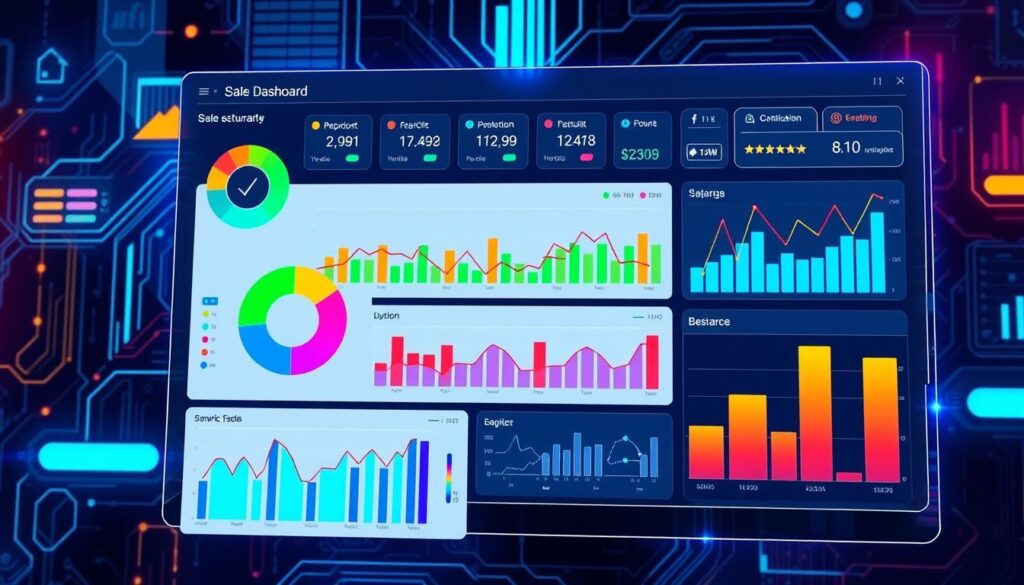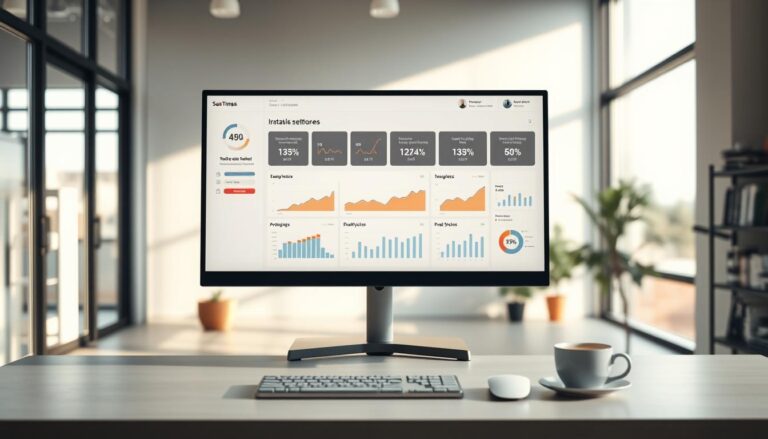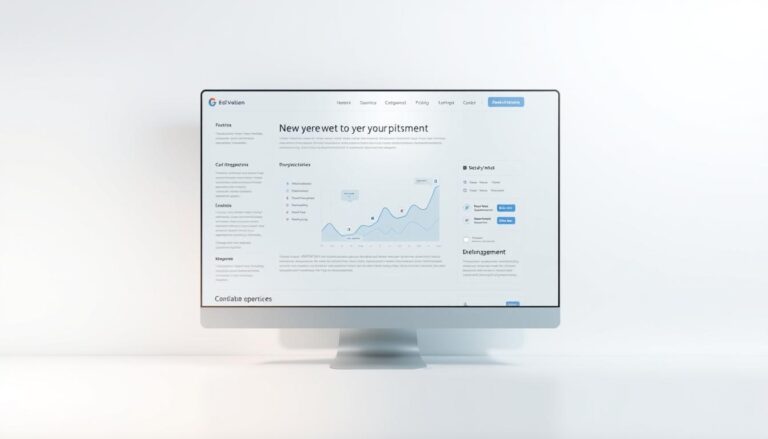The world of sales performance measurement has changed a lot due to tech. Now, we have automated sales dashboards. They are packed with features for professionals to understand their sales better. These tools look at data like revenue per sales rep, conversion rates, and how long sales take.
They help us get why sales work the way they do. And they show the best strategies.
Sales get better when we use CRM systems like HubSpot and Salesforce. They put all customer and sales info in one spot. This makes tracking leads through to sales faster and more accurate. Businesses can now look at how fast they respond to leads and if they are hitting goals.
This makes a big difference in staying ahead in a tough market.
With these dashboards, teams always know how they’re doing on key things like deal size and customer value. They keep an eye on these to meet and beat their goals. This approach is key to doing well in today’s business world.
Key Takeaways
- Automated sales dashboards facilitate real-time tracking and analysis of essential sales metrics.
- CRM integration aids in the comprehensive centralization and management of customer data.
- Key metrics such as conversion rates provide insight into the effectiveness of sales strategies.
- Automated sales insights allow for data-driven decision-making and strategic planning.
- Tools like CRM systems and automated reporting save time and improve accuracy, essential for modern sales performance analysis.
- Adopting technology in sales performance measurement contributes to enhanced team efficiency and goal attainment.
- Analytics from automated platforms support the duplication of top performers’ strategies for broader team success.
Understanding Automated Sales Performance Metrics
Enterprises aim to optimize their sales processes. They do this by embracing automated sales performance metrics. These systems analyze sales data and use predictive analytics. They change how companies forecast and improve sales outcomes.
What Are Automated Sales Performance Metrics?
Automated sales metrics are key indicators analyzed by AI software. They provide real-time insights and forecasts. This enables companies to monitor KPIs easily, with less manual work. Sales teams can track progress and adjust strategies quickly.
Importance of Automation in Sales Metrics
Automating sales metrics streamlines operations and aids in strategic decisions. With automation, businesses can close more deals and shorten sales cycles. This boosts efficiency and lets sales reps focus on generating revenue.
Automated tools give a deeper understanding of customer needs and market trends. Sales teams can predict outcomes better and tailor their approaches. This leads to significant impacts:
| Key Impact | Outcome |
|---|---|
| Reduction in Sales Cycle Length | 14% decrease on average |
| Deal Closure Rate Improvement | Up to 30% increase |
| Enhanced Decision-Making | Real-time insights lead to informed strategies |
| Productivity and Efficiency | Streamlined processes and faster operations |
| Focus on High-Value Activities | Increased revenue through strategic task allocation |
| Anticipation of Customer Needs | Predictive analytics provide foresight into client requirements |
| Optimized Resource Allocation | Effective management of time and sales resources |
Automated sales performance metrics make sales data more effective. They guide teams to work smarter and achieve better results. This changes the game for sales data use.
Key Metrics for Sales Performance
Sales today are strongly shaped by technology. Machine learning sales metrics and automated sales KPI monitoring are key. They shape strategies in many industries. To stay competitive, sales teams need to know and use key performance indicators (KPIs) well. These KPIs deeply affect their work and results.
Conversion Rates
Conversion rates are vital for checking how good sales strategies are. This number shows the share of prospects turning into customers. High conversion rates mean better sales skills and understanding customer needs. Machine learning can help improve these rates.
Average Deal Size
The average deal size shows the usual money made from deals in a time frame. Watching this metric lets teams see changes in sales success. They can find ways to make deals bigger, like finding richer clients or selling more with expert automation solutions.
Sales Cycle Length
The sales cycle length is how long it takes to close a deal after first meeting a prospect. Short cycles mean a good sales process. Long ones may show problems. Automated sales KPI monitoring helps spot and fix delays, making sales faster.

Below is a table showing some key sales metrics that get better with automation and machine learning:
| Metric | Definition | Measurement Approach |
|---|---|---|
| Sales Growth Rate | Percentage increase in sales over a period. | (Current Period Sales – Previous Period Sales) / Previous Period Sales * 100 |
| Average Deal Size | Average monetary value of closed deals. | Total Value of Deals / Number of Closed Deals |
| Customer Lifetime Value (CLV) | Total revenue expected from a single customer account. | Average Purchase Value x Average Purchase Frequency Rate x Average Customer Lifespan |
| Pipeline Coverage | Ratio of pipeline value to quota target for a specific period. | Total Pipeline Value / Quota Target |
Using automated sales KPI monitoring and machine learning sales metrics improves understanding of these important metrics. It helps teams change and improve their sales strategies for better success and more profit.
Tools and Technologies for Automation
In the fast-paced world of business, it’s key to use the latest tools and tech. This boosts sales performance. CRM systems, business intelligence software, and automated reports are crucial. They turn simple sales data into helpful insights.
CRM Systems and Their Role
CRM integration is really important in making sales smoother. With platforms like HubSpot Sales Hub, managing contacts and automating emails becomes easy. Plus, they offer deep insights with sales data analysis. So, CRM systems do more than store data—they actively improve sales management.
Business Intelligence Software
Tools like Clearbit and 6sense use AI and analytics for deep insights. They score leads and show who is ready to buy. These tools help personalize outreach to promising prospects. They turn automated sales dashboards data into smart choices.
Automated Reporting Tools
Clari and similar platforms offer AI-powered sales forecasts and deal tracking. Automated reports give leaders the latest info. This helps them make smart, data-driven sales decisions.
Adopting these tech tools cuts down manual work and sharpens sales strategies. This not only saves time but makes sales more precise and efficient.
| Tool | Features | Starting Price |
|---|---|---|
| HubSpot Sales Hub | CRM automation, email automation, sales analytics | Custom pricing |
| Clearbit | AI Native Data, Lead Scoring and Routing, B2B Contact Intelligence | Contact for pricing |
| 6sense | Predictive analytics, AI, high-intent prospect identification | Contact for pricing |
| Clari | Sales forecasting, deal management, AI-powered analysis | Contact for pricing |
| Docebo | LMS, sales training, mobile learning, content management | Contact for pricing |
| DocuSign | Electronic signatures, workflow automation | Contact for pricing |
Benefits of Tracking Sales Performance Metrics
By using automated sales insights, firms can access important data. This helps in making smarter decisions. It is about turning data into insights to increase profits and efficiency.

Real-time performance tracking tools let businesses watch their sales metrics all the time. This means sales managers can quickly change strategies to meet market needs.
Improved Decision-Making
Sales performance measurement lets companies see which strategies work best. For instance, keeping an eye on conversion rates or deal sizes helps understand sales effectiveness. This aids in planning future strategies.
Enhanced Sales Strategies
Sales tracking software makes analyzing sales data easier. It also spots trends for better planning. Knowing what works lets businesses use successful methods more widely.
Increased Team Accountability
Tracking systems automate the process, making everyone aware of their metrics. Knowing things like quota attainment motivates and creates responsibility.
Additionally, detailed insights from these systems help organizations improve constantly. This ensures growth and competitiveness in their sector.
Challenges in Implementing Automation
Switching to automation, like in sales, is praised for making things faster and more correct. But setting up systems such as AI-driven sales reporting and automated monitoring of sales KPIs is hard. Understanding these problems is key for companies that want to fully use automation.
Data Quality and Accuracy
Good AI-driven sales reporting starts with high-quality data. If the data is bad or wrong, it can mess up predictive sales analytics. This can lead to bad business choices. Keeping data correct means cleaning it regularly, checking it, and updating databases to keep info right.
Resistance to Change
Sometimes people don’t like new tech. To get people to accept automated sales KPI monitoring, bosses need to deal with the human side. They should train employees, show how the system helps, and listen to their worries. Giving workers the skills and tools to use new tech can lower resistance and support change.
Integration with Existing Systems
Mixing new automated systems with old IT setups is tough. It’s important to make sure old and new systems work well together. This avoids data problems and supports better decisions. Planning carefully and maybe using special software can help merge different systems smoothly.
Ending note, rolling out tech like predictive sales analytics and AI-driven sales reporting can change sales methods. But, focusing on data quality, accepting new tech, and integrating systems is crucial. Facing these issues with good planning and action can lead to a smooth shift to automated sales.
Best Practices for Effective Metric Analysis
Analyzing sales metrics needs a strategic, adaptable approach. This is crucial for meaningful insights and actions. To stay ahead of trends and align with goals, companies must consistently examine their data. Metrics like monthly sales growth and conversion rates are key. Knowing how to use these metrics is vital. Using a sales dashboard effectively requires certain best practices.
Regular Review and Adjustment
Successful companies understand sales dynamics change often. They regularly check metrics like monthly calls and sales bookings. This helps identify trends and improve sales processes. By reviewing these metrics often, businesses can keep optimizing. Adjusting strategies based on analysis helps keep a company competitive.
Collaborating Across Departments
Good metric analysis involves all departments. When sales, marketing, and others work together, everyone understands the sales funnel better. Sharing data about revenue or win rates helps unite strategies. This teamwork leads to a better view of customer value and satisfaction.
Setting Clear Goals and KPIs
Metrics need clear goals and KPIs to be useful. This could involve tracking sales growth or annual revenue. These must align with the company’s objectives. Solid KPIs act as success markers. They turn complex data into clear milestones. This helps teams make informed decisions.
FAQ
What Are Automated Sales Performance Metrics?
Automated sales performance metrics help measure and fine-tune sales results. They use analytics software and AI to do this. Real-time tracking and predictive analytics guide decision-making for better sales.
Why is Automation Important in Sales Metrics?
Automation in sales ensures timely performance checks and less manual work. It makes sales data more accurate, thanks to AI insights. This helps keep an eye on sales KPIs for quick strategy changes and better sales.
How Do Conversion Rates Impact Sales Performance?
Conversion rates show how many prospects actually buy. Using automated systems to watch these rates helps firms improve sales tactics. This leads to better sales results.
What is the Significance of Average Deal Size in Sales Metrics?
Knowing the average deal size helps understand revenue per sale. It offers clues on pricing, product choices, and how well sales reps are doing. This info directs choices that affect a company’s profits.
Why is Monitoring Sales Cycle Length Important?
It’s crucial because it tracks the time from meeting a prospect to sealing a deal. Short cycles mean the sales team is doing well. By studying this, firms can find and fix delays in their sales.
What Role Do CRM Systems Play in Automation?
CRM systems centralize sales data for easier management. They ensure smooth data flow and accurate sales tracking. This helps sales teams meet their goals efficiently.
How Does Business Intelligence Software Support Sales Metrics?
BI software analyzes sales data, creating insights and visual reports. It predicts sales trends, aiding teams in planning their moves based on solid data.
What Are Automated Reporting Tools and Their Benefits?
These tools automatically create sales reports, saving time and effort. They help maintain consistent KPI tracking and provide quick insights for decision-makers.
What Are the Benefits of Real-time Performance Tracking?
With real-time tracking, teams get immediate data on sales. This lets them tweak strategies on the fly and adapt quickly to market and customer needs.
How Does Increased Team Accountability Affect Sales Performance?
It brings more openness, driving reps to achieve their goals. Recognizing success and addressing issues quickly helps boost sales results significantly.
What Challenges Might Arise When Implementing Automated Sales Performance Systems?
Challenges include maintaining data quality, staff resistance, and integrating new systems smoothly. These issues need addressing to avoid workflow disruptions.
Why is Regular Review and Adjustment Necessary in Metric Analysis?
Continuous strategy reviews keep sales aligned with current market trends and goals. This adaptation is key to maximizing sales team effectiveness.
How Does Collaborating Across Departments Improve Sales Data Analysis?
Working together with marketing and customer service offers a full view of the customer journey. This understanding leads to better sales strategies.
Why is Setting Clear Goals and KPIs Important in Sales?
Clear goals and KPIs focus the sales team and track progress. This focus directs efforts towards impactful activities and unites the team towards common sales objectives.



